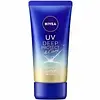What's inside
What's inside
 Key Ingredients
Key Ingredients

 Benefits
Benefits

 Concerns
Concerns

 Ingredients Side-by-side
Ingredients Side-by-side

Water
Skin ConditioningEthylhexyl Methoxycinnamate
UV AbsorberPropylene Glycol
HumectantMethylene Bis-Benzotriazolyl Tetramethylbutylphenol
UV FilterButylene Glycol
HumectantButyl Methoxydibenzoylmethane
UV AbsorberIsoamyl P-Methoxycinnamate
UV AbsorberSilica
AbrasiveOctocrylene
UV AbsorberPhenoxyethanol
PreservativeAcrylates/C10-30 Alkyl Acrylate Crosspolymer
Emulsion StabilisingTriethanolamine
BufferingMethyl Methacrylate Crosspolymer
Decyl Glucoside
CleansingDimethicone
EmollientChlorphenesin
AntimicrobialPolysorbate 20
EmulsifyingCyclopentasiloxane
EmollientTocopheryl Acetate
AntioxidantEthylhexylglycerin
Skin ConditioningXanthan Gum
EmulsifyingTrisodium Ethylenediamine Disuccinate
Dimethicone/Vinyl Dimethicone Crosspolymer
Skin ConditioningSodium Hyaluronate
HumectantWater, Ethylhexyl Methoxycinnamate, Propylene Glycol, Methylene Bis-Benzotriazolyl Tetramethylbutylphenol, Butylene Glycol, Butyl Methoxydibenzoylmethane, Isoamyl P-Methoxycinnamate, Silica, Octocrylene, Phenoxyethanol, Acrylates/C10-30 Alkyl Acrylate Crosspolymer, Triethanolamine, Methyl Methacrylate Crosspolymer, Decyl Glucoside, Dimethicone, Chlorphenesin, Polysorbate 20, Cyclopentasiloxane, Tocopheryl Acetate, Ethylhexylglycerin, Xanthan Gum, Trisodium Ethylenediamine Disuccinate, Dimethicone/Vinyl Dimethicone Crosspolymer, Sodium Hyaluronate
Water
Skin ConditioningEthylhexyl Methoxycinnamate
UV AbsorberAlcohol Denat.
AntimicrobialButylene Glycol
HumectantCaprylyl Methicone
Skin ConditioningDiethylamino Hydroxybenzoyl Hexyl Benzoate
UV FilterDiglycerin
HumectantIsopropyl Palmitate
EmollientBis-Ethylhexyloxyphenol Methoxyphenyl Triazine
Skin ConditioningDiisopropyl Sebacate
EmollientEthylhexyl Triazone
UV AbsorberBifida Polysaccharide
HumectantSilica Dimethyl Silylate
EmollientCitrullus Lanatus Fruit Extract
Skin ConditioningHydrolyzed Conchiolin Protein
Skin ConditioningPolianthes Tuberosa Polysaccharide
Skin ConditioningSodium Hyaluronate
HumectantPyrus Cydonia Fruit Extract
Skin ConditioningPolymethylsilsesquioxane
Acrylates/C10-30 Alkyl Acrylate Crosspolymer
Emulsion StabilisingLauroyl Lysine
Skin ConditioningHydroxypropyl Methylcellulose Stearoxy Ether
Dibutyl Lauroyl Glutamide
Skin ConditioningC30-45 Alkyl Methicone
EmollientC30-45 Olefin
Skin ConditioningSilica
AbrasiveTitanium Dioxide
Cosmetic ColorantCarbomer
Emulsion StabilisingPhenoxyethanol
PreservativeSodium Hydroxide
BufferingBHT
AntioxidantMethylparaben
PreservativeParfum
MaskingWater, Ethylhexyl Methoxycinnamate, Alcohol Denat., Butylene Glycol, Caprylyl Methicone, Diethylamino Hydroxybenzoyl Hexyl Benzoate, Diglycerin, Isopropyl Palmitate, Bis-Ethylhexyloxyphenol Methoxyphenyl Triazine, Diisopropyl Sebacate, Ethylhexyl Triazone, Bifida Polysaccharide, Silica Dimethyl Silylate, Citrullus Lanatus Fruit Extract, Hydrolyzed Conchiolin Protein, Polianthes Tuberosa Polysaccharide, Sodium Hyaluronate, Pyrus Cydonia Fruit Extract, Polymethylsilsesquioxane, Acrylates/C10-30 Alkyl Acrylate Crosspolymer, Lauroyl Lysine, Hydroxypropyl Methylcellulose Stearoxy Ether, Dibutyl Lauroyl Glutamide, C30-45 Alkyl Methicone, C30-45 Olefin, Silica, Titanium Dioxide, Carbomer, Phenoxyethanol, Sodium Hydroxide, BHT, Methylparaben, Parfum
 Reviews
Reviews

Ingredients Explained
These ingredients are found in both products.
Ingredients higher up in an ingredient list are typically present in a larger amount.
Acrylates/C10-30 Alkyl Acrylate Crosspolymer is a synthetic polymer. It is used to thicken and improve the texture of products. Due to its properties, it can prevent water and oil ingredients from separating.
Butylene Glycol (or BG) is used within cosmetic products for a few different reasons:
Overall, Butylene Glycol is a safe and well-rounded ingredient that works well with other ingredients.
Though this ingredient works well with most skin types, some people with sensitive skin may experience a reaction such as allergic rashes, closed comedones, or itchiness.
Learn more about Butylene GlycolEthylhexyl Methoxycinnamate is an organic compound that provides UVB protection. It often goes by the more common name of octinoxate. It is created from methoxycinnamic acid and 2-ethylhexanol.
Ethylhexyl Methoxycinnamate absorbs UVB rays with wavelengths between 280-320 nm. UV absorbers protect your skin by using chemical reactions to convert UV rays into heat and energy.
UVB (290-320 nm) rays emit more energy than UVA rays. They are capable of damaging DNA, causing sunburns and are thought to be linked to skin cancer.
The state of Hawaii has banned sunscreens containing octinoxate due to its potential impact on coral reefs. More research is needed to bridge gaps in this research. The European Union allows higher levels of octinoxate in sunscreens than the US and Australia.
Ethylhexyl Methoxycinnamate is oil soluble. It is not stable and may lose efficacy when exposed to sunlight.
Learn more about Ethylhexyl MethoxycinnamatePhenoxyethanol is a preservative that has germicide, antimicrobial, and aromatic properties. Studies show that phenoxyethanol can prevent microbial growth. By itself, it has a scent that is similar to that of a rose.
It's often used in formulations along with Caprylyl Glycol to preserve the shelf life of products.
Silica, also known as silicon dioxide, is a naturally occurring mineral. It is used as a fine, spherical, and porous powder in cosmetics.
Though it has exfoliant properties, the function of silica varies depending on the product.
The unique structure of silica enhances the spreadability and adds smoothness, making it a great texture enhancer.
It is also used as an active carrier, emulsifier, and mattifier due to its ability to absorb excess oil.
In some products, tiny microneedles called spicules are made from silica or hydrolyzed sponge. When you rub them in, they lightly polish away dead skin layers and enhance the penetration of active ingredients.
Learn more about SilicaSodium Hyaluronate is hyaluronic acid's salt form. It is commonly derived from the sodium salt of hyaluronic acid.
Like hyaluronic acid, it is great at holding water and acts as a humectant. This makes it a great skin hydrating ingredient.
Sodium Hyaluronate is naturally occurring in our bodies and is mostly found in eye fluid and joints.
These are some other common types of Hyaluronic Acid:
Learn more about Sodium HyaluronateWater. It's the most common cosmetic ingredient of all. You'll usually see it at the top of ingredient lists, meaning that it makes up the largest part of the product.
So why is it so popular? Water most often acts as a solvent - this means that it helps dissolve other ingredients into the formulation.
You'll also recognize water as that liquid we all need to stay alive. If you see this, drink a glass of water. Stay hydrated!
Learn more about Water